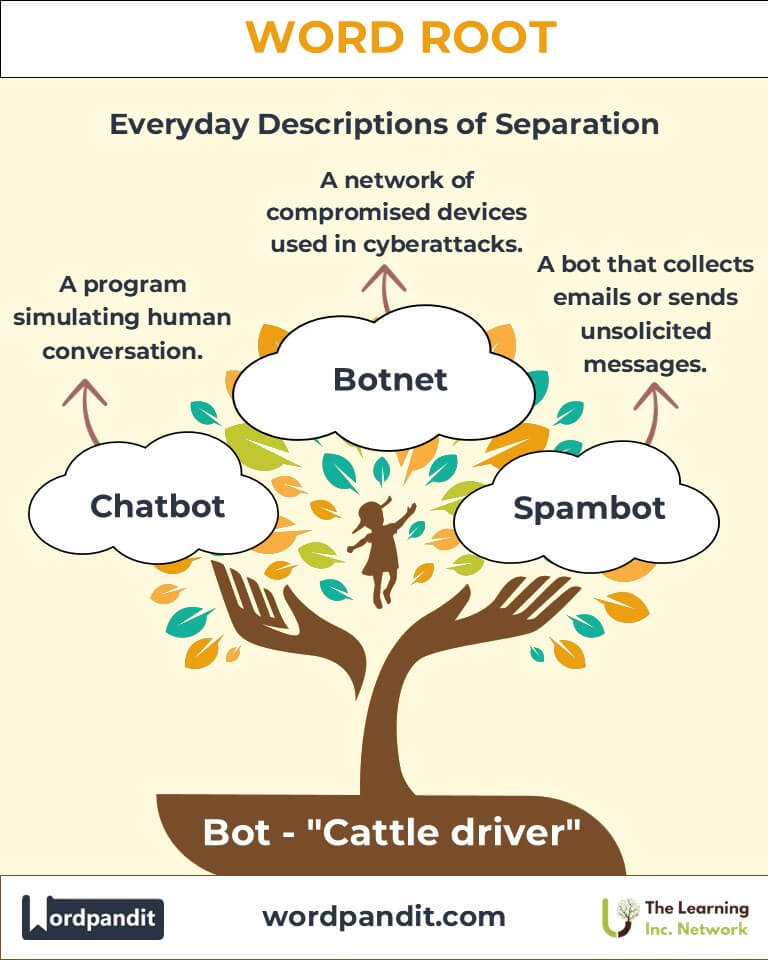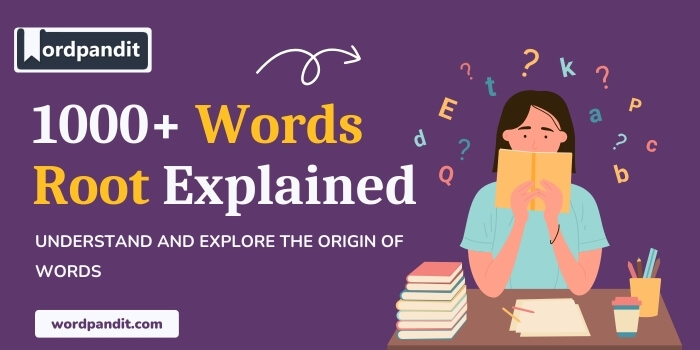Bot: Shorthand for Programs and Devices Automating Tasks
Byline:
Discover how "Bot," derived from the Greek word bótēs (meaning "cattle driver"), has evolved to symbolize automation, efficiency, and technological innovation. Learn its impact on fields like cybersecurity, finance, and healthcare.

Table of Contents
- Introduction: The Origin and Modern Role of Bots
- Etymology and Historical Journey
- Mnemonic: Unlocking the Power of Bot
- Common Bot-Related Terms
- Bot Through Time
- Bot in Specialized Fields
- Illustrative Story: Bot in Action
- Cultural Significance of the Bot Root
- The Bot Family Tree
- FAQs about the Bot Word Root
- Test Your Knowledge: Bot Word Root Quiz
- Conclusion: The Enduring Legacy of Bot
Introduction: The Origin and Modern Role of Bots
"Bot" is shorthand for programs and devices that execute tasks independently, embodying humanity's quest for efficiency and innovation. Whether managing conversations via chatbots or orchestrating trades in finance, bots have become indispensable in today’s tech-driven world.
Etymology and Historical Journey
The root "Bot" originates from the Greek bótēs, meaning "cattle driver" or "herdsman." Historically, it referred to guidance and control, traits aligning seamlessly with the modern concept of bots as task managers. The term "robot" first appeared in Karel Čapek’s 1920 play R.U.R. (Rossum’s Universal Robots), derived from the Czech word robota, meaning "forced labor." Over time, "Bot" has become synonymous with automation in both physical and digital realms.
Mnemonic: Unlocking the Power of Bot
To remember the root "Bot," envision a shepherd guiding a flock of sheep, much like bots manage and automate tasks in technology.
Mnemonic:
"Bot—Guiding tasks like a herdsman controls a flock."
Common Bot-Related Terms
- Chatbot (CHAT-bot): A program simulating human conversation through text or voice.
Example: "The chatbot provided instant support to customers online." - Botnet (BOT-net): A network of compromised devices controlled by a malicious entity.
Example: "The botnet launched a coordinated cyberattack." - Spambot (SPAM-bot): A bot designed to collect email addresses or send unsolicited messages.
Example: "A spambot filled the inbox with ads." - Web Crawler (WEB craw-ler): A bot that systematically browses the internet to index content.
Example: "Search engines rely on web crawlers to organize information." - Game Bot (GAYM bot): Software used in gaming to automate repetitive tasks or actions.
Example: "The game bot farmed resources overnight."
Bot Through Time
- Automaton: Early mechanical devices mimicking human or animal actions, inspiring modern robots.
- Robot: Popularized by Čapek’s R.U.R., bridging historical automatons with contemporary bots.
Bot in Specialized Fields
- Cybersecurity: Botnets disrupt online services through attacks like DDoS.
- Digital Marketing: SEO bots automate content indexing to enhance web visibility.
- Finance: Trading bots analyze market trends and execute high-frequency trades.
- Healthcare: Medical chatbots assist in symptom analysis and appointment scheduling.
Illustrative Story: Bot in Action
Sophia, a small business owner, struggled to manage customer inquiries. She implemented a chatbot to handle FAQs and route complex queries to her team. The bot's efficiency allowed Sophia to focus on growth while ensuring customers received timely support. Her story highlights how bots simplify tasks and enhance productivity.
Cultural Significance of the Bot Root
From ancient automatons to modern robots, the "Bot" root mirrors society’s evolving relationship with technology. Bots feature prominently in pop culture, from movies like The Terminator to everyday tools like Alexa, symbolizing both fascination and caution regarding automation.
The Bot Family Tree
- Auto- (Self): Example: Autonomous – Acting independently.
- Mech- (Machine): Example: Mechanism – A system of parts working together.
- Techno- (Art, Skill): Example: Technophile – A lover of technology.
FAQs About the Bot Word Root
Q: What does "Bot" mean?
A: The root "Bot" originates from the Greek bótēs, meaning "cattle driver" or "herdsman." In modern contexts, it refers to automated programs or machines designed to perform specific tasks efficiently.
Q: How does a chatbot work?
A: A chatbot operates through natural language processing (NLP) and artificial intelligence to simulate human conversation. It can answer questions, resolve issues, and interact with users in real-time.
Q: What is the difference between a botnet and a web crawler?
A: A botnet is a malicious network of compromised devices used to perform harmful activities like cyberattacks. In contrast, a web crawler is a legitimate tool employed by search engines to index web content systematically.
Q: How are bots used in finance?
A: In finance, trading bots use algorithms to analyze market trends and execute trades quickly. They help investors optimize profits by making decisions based on predefined criteria.
Q: What is the cultural impact of robots and bots?
A: Bots and robots have influenced culture through literature, films, and daily life. They symbolize human ingenuity and the potential risks of overreliance on technology, as seen in works like The Terminator and real-world applications like Alexa.
Test Your Knowledge: Bot Word Root Quiz
1. What does "Bot" originally mean?
2. Which term describes a malicious network?
3. What is a web crawler?
4. How do trading bots operate?
5. What is a spambot designed to do?
Conclusion: The Enduring Legacy of Bot
The root "Bot" epitomizes the intersection of language, technology, and innovation. From its origins as a "cattle driver" to its role in modern automation, "Bot" reflects humanity’s drive to simplify tasks and enhance efficiency. As technology evolves, the relevance of bots will only grow, shaping industries and everyday life. Embrace the world of "Bot" and its transformative potential!













